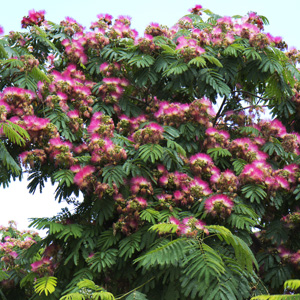Albizia julibrissin (Silk Tree)
Arabic name: ألبيزيا
The Silk Tree (Albizia julibrissin), also known as Mimosa, is native to Southwest Asia, where it grows in woods and on riverbanks. This beautiful, but relatively short-lived ,deciduous tree can grow to a height of 6m, with a spread of 8m, and has a fast growth rate of about 25 - 50cm per year. It is an airy, tropical-looking tree with a flat spreading crown, leaves that fold at night, and fluffy pink flowers that appear from May to June.
Requirements:
Silk trees grow in full sun or partial shade, and are drought-tolerant. They grow best in the middle of an open area, where their limbs can reach their full spread.
Water usage:
Silk Trees require some irrigation once established. Generally, trees need supplemental irrigation to get established, especially if planted after the rainy season. During the first year, irrigate in the amount of 20 – 25 liters of water twice a week. During its second year, a tree needs to be irrigated in the amount of 40 liters once a week. Beginning with the third year, trees usually get established, and some, like the Silk Tree, require some supplemental irrigation in the amount of 50 – 60 liters once a month.
Appearance:
The Silk Tree is a medium-sized lacy and graceful, spreading tree. It is often multi-stemmed, and forms a flat-topped crown. Its attractive feathery leaves are finely divided, and grow to 50 cm long, with numerous small, taper-pointed, un-toothed leaflets. The leaflets, which are about 1cm long, are dark green and smooth on both sides. Leaves alternate along the stems. Showy and fragrant pink flowers are borne in dense, fluffy pink clusters grouped at the end of branches, and resemble fluffy pincushions, opening in early summer. Fruits are flat, straw-colored pods. They are about 15cm in length and contain light brown oval-shaped seeds. The pods ripen in August.
Notes on use:
A specimen tree; distinguished by its striking pink flowers; provides filtered shade. Shade canopy can provide shelter for heat-sensitive under-plantings. Also used for street sides, medians, and parks.
Propagation:
Silk Trees reproduce by vegetative suckers and seed.
Trees from containers should be at least one year of age, and should be planted in the spring. Stake for support until established.
Maintenance:
Needs pruning to develop a high-headed tree. Prune low branches and buds yearly to train to a high crown form.
The Silk Tree produces litter from flowers, leaves, and pods, which may necessitate occasional cleaning.
Comments:
Silk Tree blossoms are fragrant and practically drip with nectar. They are attractive to hummingbirds, honeybees and butterflies.
Silk Trees can become invasive.
Image source: https://www.gardenexpress.com.au
Image source: https://www.gardeningexpress.co.uk
This article is part of a series of articles prepared by the Center for the Study of the Built Environment (CSBE) on water conserving landscapes.
For additional information on water conserving gardens, visit the CSBE web site at www.csbe.org
Support for the CSBE project on water conserving landscapes is provided by WEPIA (Water Efficiency and Public Information for Action), a program being implemented in collaboration with the Ministry of Water and Irrigation and funded by the United States Agency for International Development (USAID).


